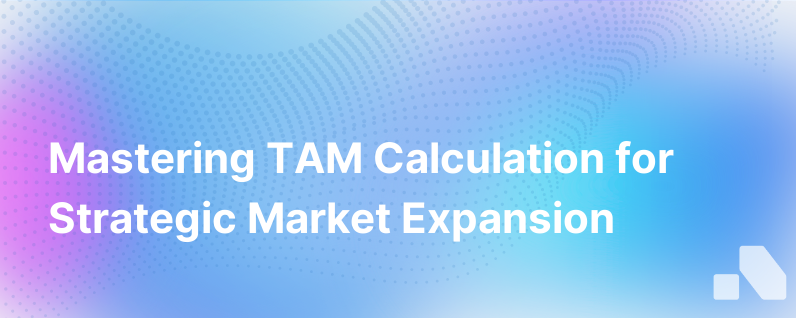How To Calculate Tam Total Addressable Market
Published on August 28, 2023 by David Zhang
Calculating Total Addressable Market (TAM) is like setting the stage for a performance—knowing your audience’s scale tells you how grand the show could be. For businesses, TAM represents the full demand for their products or services, translating to the ultimate revenue opportunity available if 100% market share was achieved. It’s foundational for startups to investors understanding the peak of market potential.
In this guide, we'll sail through the intricacies of TAM calculation, breaking down what it is, why it matters, and providing a step-by-step guide on how to calculate it, using real-world examples for clarity.
Understanding TAM
The concept of the Total Addressable Market is rooted in the premise of possibility and potential. It defines the total market demand for a product or service, painting a picture of the potential market size that a company could aim to capture.
TAM is crucial for several reasons:
- Guiding Strategy: It informs strategic decisions like market entry, product development, and resource allocation.
- Attracting Investment: Investors typically want to back companies with a large TAM because it suggests promising growth opportunities.
- Benchmarking: By understanding your TAM, you can benchmark your company against the industry size and work out market share.
How to Calculate TAM
TAM can be approached through three primary methods: Top-Down Analysis, Bottom-Up Analysis, and Value Theory Approach. Each offers different vantage points of the market landscape.
Top-Down Analysis
This approach uses industry data and market reports to calculate TAM. It requires you to start with broad data at the industry level and narrow it down to your specific part of the market.
Here’s how to conduct a top-down analysis:
- Identify Relevant Industry Metrics: Find data on industry size and growth from research firms such as Gartner, Forrester, or government databases.
- Segment the Market: Break down the industry figures according to the segments that pertain to your product/service.
- Apply Market Filters: Factor in relevant geographic, demographic, and psychographic limitations that apply to your product/service.
- Calculate TAM: Multiply the segmented market value by the percentage that’s relevant to your product and applies to your market scope.
For example, if the global market for educational software is $20 billion, and you’re targeting the U.S. market, which constitutes 25% of this figure, then your TAM for the U.S. would be $5 billion.
Bottom-Up Analysis
This method calculates TAM based on primary data and direct observation, offering a more precise and often conservative number than top-down analysis.
Here’s the bottom-up calculation process:
- Start with a Unit Price: Determine your product's average selling price.
- Estimate the Customer Base: Count the number of potential customers in the market that could buy your product.
- Calculate TAM: Multiply the unit price by the number of potential customers.
For instance, if the unit price of your CRM software is $500 and you identify 2 million businesses that could use it, your TAM would be $1 billion.
Value Theory Approach
This approach is a bit more abstract and involves assessing the value (or utility) customers would derive from your product, as opposed to the current alternatives.
Here's how you might calculate TAM using the value theory approach:
- Assess the Problem: Define the customer problem or need your product solves.
- Quantify the Value Proposition: Estimate the willingness to pay or how much value customers currently get from existing solutions.
- Determine Potential Market Size: Assess the number of potential customers and the value improvement your solution offers.
- Calculate TAM: Estimate how much the market would be willing to pay for the added value your product provides and multiply by the number of customers.
Say you offer a new logistics software that saves companies an average of $10,000 annually compared to current solutions, and there are 100,000 potential customers, the TAM would be $1 billion.
Common Challenges in TAM Calculation
While the principle sounds straightforward, several challenges arise in calculating TAM accurately:
- Lack of Reliable Data: Especially for new markets or niches, pertinent data might be incomplete or nonexistent.
- Rapidly Changing Markets: In sectors with high innovation rates, TAM can fluctuate quickly, making static measurements less reliable.
- Subjectivity in Segmentation: Decisions about market segmentation often involve a degree of subjectivity, which can affect accuracy.
Leveraging TAM Calculation
Calculating TAM is more than an exercise—it’s a strategic tool. By understanding the TAM for your products or services, you can:
- Prioritize Markets: Which geographies or demographics offer the most potential?
- Develop Business Cases: TAM figures help substantiate feasibility studies or business plans.
- Measure Market Penetration: Use TAM to measure what percentage of the total potential market you've captured.
In targeting your market effectively, you may look toward innovative solutions like Aomni that provide AI-driven insights to sharpen your sales strategy further.
Concluding Thoughts
The task of calculating a startup's TAM isn't just about mathematics. It’s about vision—a well-constructed TAM model reflects ambition tempered with realism. Smoothing the edges of the TAM calculation process requires access to the right data, tools, and market understanding.
The dynamic nature of TAM increases the value of an adaptable and accurate calculation process. In the spirit of precision and growth, truly strategic companies invest in tools like Aomni to continually capture and analyze evolving market opportunities, ensuring their sails are always catching the prevailing winds of their Total Addressable Market.
Gaining a deep understanding of TAM empowers your business with critical information that guides your strategies and enables you to communicate your market potential to stakeholders and investors. As a piece of the broader strategic puzzle, knowing your TAM sets the foundation for structured, scalable growth.